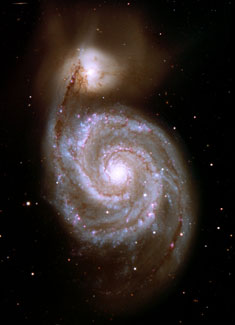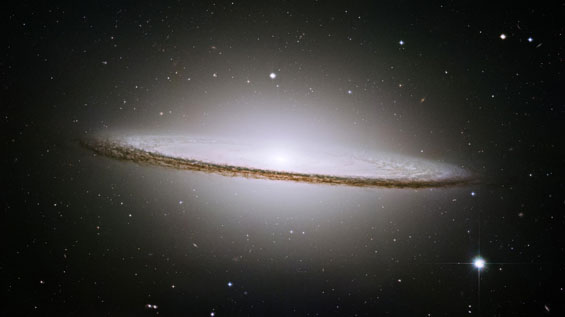
“Many of the brightest stars are hundreds of light years away, so you can walk outside at night and see stars whose light was emitted before your parents were born,” says Kenneth Lang. This is M51, the Whirlpool Galaxy. Photo: Courtesy of NASA
Ask The Professor
How are astronomical distances determined?
Kenneth R. Lang, a professor of astronomy, gives us the lowdown:
The distance to a planet can be estimated by measuring the angular separation of the planet when observed simultaneously from two widely separated locations. This angle is known as parallax, from the Greek parallaxis, for the “value of an angle.” If both the parallax and the separation between the two observers are known, then the distance of the planet can be determined by triangulation. It is based on the geometric fact that if you know the length of one side of a triangle and the angles of the two corners, all the other dimensions can be calculated.
The parallax technique of estimating a planet’s distance is similar to the way your eyes infer how far away things are. To see the effect, hold a finger up in front of your nose, and look at your finger with one eye open and the other closed, and then with the open eye closed and the closed one open. Any background object near to one side of your finger seems to move to the other side, making a parallax shift. When this is repeated with your finger held farther away, the angular shift is smaller. In other words, the more distant an object, the smaller the parallax shift, and vice versa.
Significant improvements in the precision of measuring planetary distances came in the late 1960s by bouncing pulsed radio waves off Venus and timing the echo. The round-trip travel time—about 276 seconds when Venus is closest to the Earth—was measured using accurate atomic clocks, and a precise distance to Venus was then obtained by multiplying half the round-trip time by the speed of light. The distance of Venus from the Sun is equal to one half of the difference between the Earth and Venus when it is closest and furthest away from us, on the other side of the Sun.
Once the Venus-Sun distance is known, we can infer the distance of any other planet from the Sun using Kepler’s third law, which relates the orbital periods and orbital distances of the planets. The mean distance between the Earth and the Sun, known as the astronomical unit, is 149.6 million kilometers. At this distance it takes 499 seconds, or about 8.3 minutes, for light to travel from the Sun to the Earth, moving at the velocity of light, 299,792 kilometers per second.
Triangles and Stars
To triangulate the distances of the nearest stars, other than the Sun, astronomers measured their parallax when viewed across the widest possible baseline, from opposite sides of the Earth’s annual orbit, or from a separation of twice the astronomical unit. The measurement involves careful scrutiny of two stars that appear close together in the sky, a bright one that is relatively nearby and the other fainter one that is much further away.
The annual parallax of the nearest star can then be determined by comparing its position to that of the distant one for a year or more. During the course of the year, the nearby star will seem to sway to and fro, in a sort of cosmic minuet that mirrors the Earth’s orbital motion. The nearer the star, the larger the annual parallax sway.
The first star whose distance was reliably determined in this way was 61 Cygni, whose annual parallax of just 0.31 seconds of arc was announced by Friedrich Wilhelm Bessel in 1838. The measurement indicated that 61 Cygni is about 700 thousand times further away than the Sun. Traveling at the speed of light, it takes 11.4 years to cross the distance from 61 Cygni to Earth.
Within a century of Bessel’s result, the annual parallax of about 2,000 nearby stars had been determined using long exposures on photographic plates, and the number tripled in succeeding decades. The closest star, known as Proxima Centauri, is 4.22 light years away. And many of the brightest stars are hundreds of light years away, so you can walk outside at night and see stars whose light was emitted before your parents were born.
Distant stars with parallaxes smaller than 0.05 seconds of arc cannot be measured with Earth-based telescopes because of atmospheric distortion that limits their angular resolution. However, instruments aboard the HIPPARCOS satellite, which orbited the Earth above its atmosphere in the 1990s, pinpointed the position of more than 100,000 stars with an astonishing precision of 0.001 seconds of arc, determining the parallax and distance of many of them out to a few hundred light-years.

M104, the so-called Sombrero Galaxy, which is 50,000 light-years across and 28 million light years from Earth. Photo: NASA and the Hubble Heritage Team (STScI/AURA).
Distant Galaxies
The distances to exceptionally bright stars, known as the Cepheid variable stars after their prototype, have been determined out to millions of light years. When observing Cepheids that were grouped together at roughly the same distance, Henrietta Leavitt found in 1912 that their variation periods are proportional to their intrinsic brightness, or absolute luminosity.
And once the distance of a nearby Cepheid had been established by another method, say by its annual parallax, then the period-luminosity relation could be calibrated and used to infer the distances of all the other Cepheids. Just measure the variation period, which provides its absolute luminosity, and compare that to the observed apparent luminosity. Since the luminosity falls off with the square of the distance, the comparison provides a measure of the distance.
In 1925 Edwin Hubble used Cepheid variables in nearby spiral nebulae to show that they are remote galaxies located outside the Milky Way, at distances of about one million light-years. The Milky Way no longer contained everything there is, and the universe was opened wide up. It was no longer limited to the things our unaided eyes can focus on, and our stellar system became just one of myriad galaxies that stretch as far as the largest telescopes can see—and even beyond.
After using Cepheid variable stars to infer the distances of just a few nearby spiral nebulae, Hubble estimated the distances of several other galaxies by assuming that their brightest stars are intrinsically as bright as the most luminous stars in the Milky Way. The method is analogous to judging the distance of an approaching car at night from the brightness of its headlights; the lights of closer cars are brighter.
By 1929, Hubble had approximate distance measurements for just 24 spirals, and he compared these distances to their radial velocities, inferred by other astronomers using the Doppler effect. The comparison indicated that the more distant a galaxy is, the faster it is moving away from us.
The connection between velocity and distance, which applies to all of the most distant galaxies, is now known as Hubble’s law, and the ratio of the velocity of recession of any galaxy and its distance from us is now called Hubble’s constant, a fundamental measure of the universe. Modern estimates, using the Hubble Space Telescope to observe Cepheids out to about 65 million light-years, indicate Hubble’s constant has a value of about 70 kilometers per second per Megaparsec, abbreviated Mpc, where one Mpc is equivalent to 3.26 million light-years. Galaxies are typically separated by a few Mpc, or about 10 million light-years, which is about 100 galaxy diameters. So the universe is largely empty space as far as galaxies are concerned.
The age of the observable universe, the time since its expansion began with the Big Bang, is given by the reciprocal of Hubble’s constant, establishing an age of about 14 billion years. This means that some galaxies are so remote that they emitted the light we see today more than 10 billion years ago. These objects are seen as they were then and not as they might be now.
Distances to remote galaxies, where Cepheids cannot be resolved, are determined using a succession of methods known as the cosmic distance ladder. Objects of known absolute luminosity, or standard candles, are used to infer distances from apparent luminosities, and different standard candles are used over various ranges of distance, or rungs on the ladder.
An exploding star, known as supernova, is an example of a standard candle used for distances of billions of light-years; it briefly shines with the light of an entire galaxy containing one hundred billion non-exploding stars like the Sun. Recent comparisons of supernovae explosions in nearby and very remote galaxies indicate that the universe is not expanding at a uniform rate, but instead is speeding up as time goes on, propelled by a mysterious dark energy that we know virtually nothing about. And since there is also about 10 times more dark, invisible matter in the universe than visible matter, our current ignorance over the unknown state of the cosmos is staggering.
Kenneth R. Lang is the author of Parting the Cosmic Veil (Springer, 2006).
Have a question for “Ask the Professor”? Email taylor.mcneil@tufts.edu.


